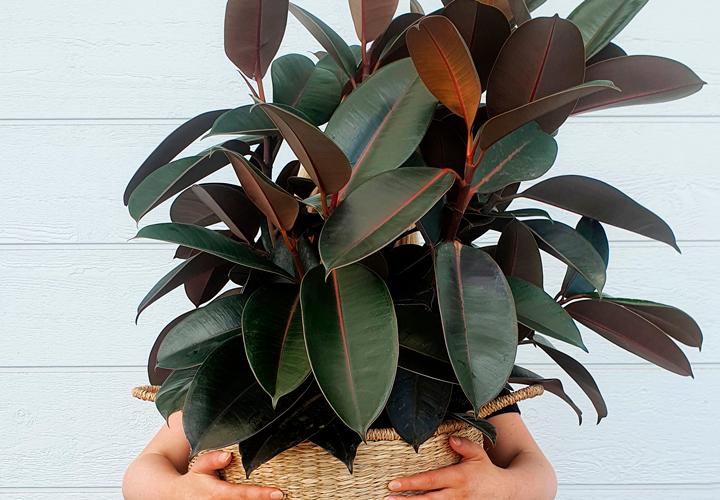Whether you know it as a rubber tree, a burgundy fig or by its botanical name of Ficus elastica, there’s no doubt that this is one of the most popular houseplants. And for good reason – rubber plants are incredibly hardy, with a great tolerance for a range of growing conditions making their care needs near impossible to get wrong. Not only are they easy to grow, they’re also very attractive, with broad, leathery, oval-shaped leaves that have a great shine to them. With all these facts going for them, you’ll want to get one into your home, stat!
A word of warning
All varieties of rubber plant are best kept contained in pots, because of their prolific growth and invasive root systems. When planted in the ground they can reach over 20m in height and their spreading roots can cause untold damage to driveways, paving, swimming pools and even house foundations. Keep them potted for manageable growth.
You are watching: Ficus Elastica Guide: How To Care For Your Rubber Plant
Quick reference care guide
Watering
Nail the watering for this plant and there’s not much else you need to do. Both overwatering and underwatering can cause problems. Ideally, your rubber plant will thrive in soil that is well-drained and watered only moderately – our best advice is to poke a finger into the potting mix up to your first knuckle to check how wet it is. If it’s still wet, hold off, but if it’s dry, give the plant a thorough soaking and allow it to drain. Keep in mind your plant might take longer to dry out in cooler weather, so your watering frequency may change through the year.
Pot requirements
Good drainage is a must for these plants, so choose a pot that suits. We always recommend that you leave your new plant in its nursery pot, which you can then slip snugly inside a decorative indoor pot. When it’s time to water, simply slip the nursery pot out of the decorative pot and take it outside or to your bathroom so you can water thoroughly and allow it to drain. As fast growers, these plants will need repotting into a larger pot every year or two, with fresh potting mix to replenish nutrients. Read more about repotting here.
Potting mix
As with most indoor plants, we recommend Supersoil Professional Indoor, Balcony and Hanging Basket Mix. This well-draining formula has the ideal mix of nutrients and slow-release fertiliser to nourish your rubber plant and help it grow.
Light requirements
Rubber plants will tolerate a range of light conditions indoors, but grow best in bright, indirect sunlight – and as a bonus, for variegated varieties, brighter sunlight usually produces stronger variegation. When grown in darker spots these plants do have a tendency to stretch toward a light source, so be sure to turn them regularly. Struggling for light in your home? Try a grow light!
Humidity
These plants aren’t fans of super dry air, which can become a problem if they’re situated in a draughty spot or in the path of an air conditioner or heater. Move your plants away from these areas and, if necessary, up the humidity with the occasional water spritz or by grouping plants closely together to create a more humid microclimate.
Fertiliser
Read more : 12 DIY Greenhouse Plans for Gardeners on a Budget
These guys aren’t the hungriest of feeders, but a monthly liquid feed during the growing season (late spring to early autumn) never goes astray. We recommend Osmocote Pour + Feed Indoor Plant Food. Outside of this growing period there’s no need to feed your rubber plant!
Pruning
If your rubber plant is growing too large for your home, you can either pinch out new leaves from the growing tip as they appear or give the plant a trim at the top during growing season – that’s any time between spring and autumn. Always use sharp, clean cutting tools to prevent the spread of disease, and ensure you cut just above a node.
Varieties
Inspired to grow your own rubber plant? Here’s a list of some of the varieties you’ll find at your local Flower Power Garden Centre. Click here to shop them all.

Burgundy »
The classic variety, with shiny, deep green, leathery leaves that look almost burgundy with a rust-toned underside and vibrant pink-sheathed new growth. The midribs and stems are distinctly red. Kept in a pot indoors this plant can still reach up to 4 metres high and 3 metres wide, but left to grow outdoors in the ground the sky is quite literally the limit.

Melany »
Read more : testing
More compact than a traditional rubber tree, this version features glossy, burgundy-green leaves. The potential growth on this variety is up to 1 metre high and wide.

Tineke »
A range of sedate green tones combine with cream around the edges to create a blotched effect reminiscent of camouflage, and a distinct pink midrib. This is another small variety with potential growth up to 1 metre high and wide when grown in an indoor pot.

Tineke Ruby »
Very similar to Tineke, however a red cast over the entire leaf turns the cream to eye-catching pink. The compact size of this plant is also very similar to its creamy-coloured sister – just 1 metre high and wide indoors.

Marble »
A newer variety of rubber plant. Again, similar to Ficus Tineke, but featuring a gorgeous mottled or marbled cast over the whole leaf.
Source: https://gardencourte.com
Categories: Outdoor


